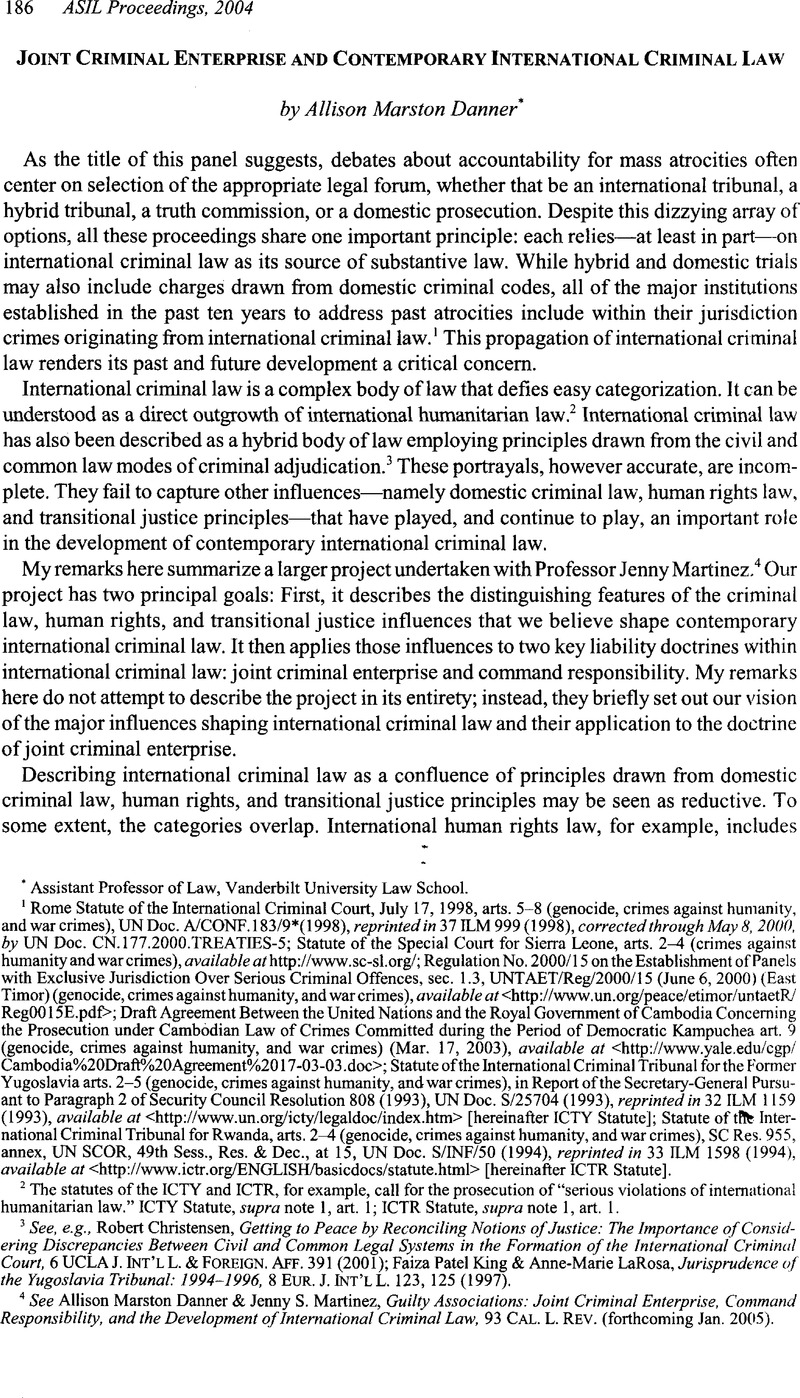Article contents
Joint Criminal Enterprise and Contemporary International Criminal Law
Published online by Cambridge University Press: 28 February 2017
Abstract

- Type
- Accountability for War Crimes: What Roles for National, International, and Hybrid Tribunals?
- Information
- Copyright
- Copyright © American Society of International Law 2004
References
1 Rome Statute of the International Criminal Court, July 17, 1998, arts. 5-8 (genocide, crimes against humanity, and war crimes), UN Doc. A/CONF. 183/9*(1998), reprinted in 37 ILM 999 (1998), corrected through May 8, 2000, by UN Doc. CN.177.2000. Treaties-5; Statute of the Special Court for Sierra Leone, arts. 2-4 (crimes against humanity and war crimes), available at http://www.sc-sl.org/; Regulation No. 2000/15 on the Establishment of Panels with Exclusive Jurisdiction Over Serious Criminal offences, sec. 1.3, UNTAET/Reg/2000/15 (June 6, 2000) (East Timor) (genocide, crimes against humanity, and war crimes), available at <http://www.un.org/peace/etimor/untaetR/RegOO15E.pdf>; Draft Agreement Between the United Nations and the Royal Government of Cambodia Concerning the Prosecution under Cambodian Law of Crimes Committed during the Period of Democratic Kampuchea art. 9 (genocide, crimes against humanity, and war crimes) (Mar. 17, 2003), available at <http://www.yale.edu/cgp/Cambodia%20Draft%20Agreement%2017-03-03.doc>; Statute of the International Criminal Tribunal for the Former Yugoslavia arts. 2-5 (genocide, crimes against humanity, and war crimes), in Report of the Secretary-General Pursuant to Paragraph 2 of Security Council Resolution 808 (1993), UN Doc. S/25704 (1993), reprinted in 37 ILM 1159 (1993), available at <http://www.un.org/icty/legaldoc/index.htm> [hereinafter ICTY Statute]; Statute of trfc International Criminal Tribunal for Rwanda, arts. 2-1 (genocide, crimes against humanity, and war crimes), SC Res. 955, annex, UN SCOR, 49th Sess., Res. & Dec, at 15, UN Doc. S/INF/50 (1994), reprinted in 37 ILM 1598 (1994), available at <http://www.ictr.org/ENGLISH/basicdocs/statute.html> [hereinafter ICTR Statute].
2 The statutes of the ICTY and ICTR, for example, call for the prosecution of “serious violations of international humanitarian law.” ICTY Statute, supra note 1, art. 1 ; ICTR Statute, supra note 1, art. 1.
3 See, e.g., Christensen, Robert, Getting to Peace by Reconciling Notions of Justice: The Importance of Considering Discrepancies Between Civil and Common Legal Systems in the Formation of the International Criminal Court, 6 Ucla J. Int’l L. & Foreign. Aff. 391 (2001)Google Scholar; King, Faiza Patel & LaRosa, Anne-Marie, Jurisprudence of the Yugoslavia Tribunal: 1994-1996, 8 Em. J. Int’l L. 123, 125 (1997)Google Scholar.
4 See Danner, Allison Marston & Martinez, Jenny S., Guilty Associations: Joint Criminal Enterprise, Command Responsibility, and the Development of International Criminal Law, 93 Cal. L. Rev. (forthcoming Jan. 2005)Google Scholar.
5 By this phrase, I refer to certain general features common to most sophisticated municipal criminal law systems, particularly the principle of individual culpability. See Damaška, Mirjan, The Shadow Side of Command Responsibility, 49 Am. J. Comp. L. 455, 470 (2001)CrossRefGoogle Scholar.
6 Prosecutor v. Tadic, Judgement, Appeals Chamber, Case No. IT-94-l-Apara. 186 (July 15, 1999) [hereinafter Tadic V] (stating “The basic assumption must be that in international law as much as in national systems, the foundation of criminal responsibility is the principle of personal culpability: nobody may be held criminally responsible for acts or transactions in which he has not personally engaged or in some other way participated”).
7 The rule of strict construction of penal statutes represents one such device. See, e.g., Prosecutor v. Kayishema & Ruzindana, Judgement, Trial Chamber, Case No. ICTR-95-1-T para. 103.
8 See Heifer, Laurence R., Overlegalizing Human Rights: International Relations Theory and the Commonwealth Caribbean Backlash Against Human Rights Regimes, 102 Colum.L.Rev. 1832, 1887 (2002)Google Scholar. In criminal law trials, by contrast, the offenses are, at least in theory, strictly construed in favor of the defendant.
9 See, e.g., Velasquez Rodriguez Case, Judgement, Inter-Am. C.H.R. (Ser. C), No. 4, para. 172 (1988).
10 See generally, Ruti G. Teitel, Transitional Justice (2001 ); Transitional Justice and the Rule of Law in New Democracies (A. James Mcadams Ed., 1997); Transitional Justice: How Emerging Democracies Reckon with Former Regimes (Neil J. Kritz, ed. 1997).
11 The gacaca proceedings used in Rwanda, for example, provide an example of such an indigenous mechanism. See Drumbl, Mark A., Toward a Criminology of International Crime, 19 Ohio St. J. on Disp. Resol. 263, 275 (2003)Google Scholar.
12 See Cassese, Antonio, Reflections on International Criminal Justice, 61 Mod. L. Rev. 1, 6 (1998)CrossRefGoogle Scholar.
13 Joint criminal enterprise is also referred to by other terms, such as “common purpose” and “common plan” liability. See Prosecutor v. Radoslav Brdanin & Momar Talic, Decision on Form of Further Amended Indictment and Prosecution Application to Amend, June 26, 2001, para. 24, 2001 WL 1793829.
14 See Prosecutor v. Multinovic et al., Decision on Dragoljub Ojdanie’s Motion Challenging Jurisdiction—Joint Criminal Enterprise, Appeals Chamber, Case No. IT-99-37-AR72 (May 21, 2003).
15 Tadic V, supra note 6, para. 190.
16 See, e.g.. Prosecutor v. Multinovic et al., supra note 14, para. 26.
17 Prosecutor v. Milosevic, Initial Indictment, Case No. IT-01-51-I para. 6 (Nov. 22, 2001) Prosecutor V.Milosevic, First Amended Indictment, Case No. IT-02-54-T para. 6 (Oct. 23, 2002); Prosecutor v. Milosevic et al, Second Amended Indictment, Case No. IT-99-37-PT para. 16 (Oct. 16, 2001).
18 United States v. Ibrahim Ahmed Mahmoud al Qosi, Charge: Conspiracy para. 18 (Feb. 24, 2004), available at <http://www.defenselink.mil/news/Feb2004/d20040224Al Qosi.pdf>; United States v. Ali Hamza Ahmad Sulayman al Bahlul, Charge: Conspiracy para. 14 (Feb. 24, 2004), available at <http://www.defenselink.mil/news/Feb2004/d20040224AlBahlul.pdf>.
- 1
- Cited by


